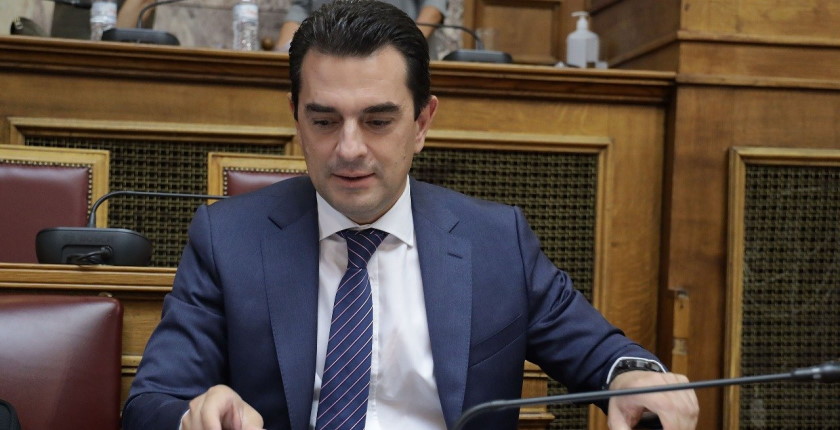
Photo: Ministry of Environment and Energy
Minister of Environment and Energy Kostas Skrekas said the government would mobilize over EUR 44 billion for the structural transformation of Greece’s energy sector by the end of the decade. The aim is to increase the installed renewable energy capacity to 25 GW from 9 GW and also triple the volume for LNG storage.
The energy strategy of Prime Minister Kyriakos Mitsotakis’s cabinet is to keep energy affordable in Greece, support consumers and energy efficiency measures, secure supply and strengthen competitiveness by accelerating the green transition and achieving independence from Russian fossil fuel imports, according to Kostas Skrekas.
It was the first country in Europe to start subsidizing electricity and gas bills for households and businesses, he noted in an op-ed for energypress.gr. The minister of environment and energy added that Greece allocated more than EUR 4.5 billion so far to shield the society from energy price spikes. A temporary mechanism will divert windfall profits in the segment to the entire population, Skrekas pointed out.
Energy crisis support measures will amount to EUR 6.5 by the end of the year
The scheme is projected to recover over EUR 1.6 billion by the end of the year, he said. Skrekas added that support measures through December 2022 would come in at more than EUR 6.5 billion, arguing they are the biggest in the European Union in comparison with other member states.
Gas interconnections with Bulgaria, North Macedonia
Just a few days after the start of the war in Ukraine, the government decided to upgrade the storage capacity of Hellenic Gas Transmission System Operator’s (DESFA) liquefied natural gas (LNG) station in Revithoussa, also known as Revythousa, the minister noted. In combination with the new stations in Corinth and Alexandroupolis, which is already under construction, Greece is establishing itself as the main gateway for natural gas in Southeastern Europe and tripling its LNG storage capacity, in his words.
Greece is establishing itself as the main gateway for gas in Southeastern Europe
Skrekas revealed that Revithoussa met 43% of the country’s natural demand so far this year. The volume of gas imports from Russia will be further reduced with the increase of the capacity of the Trans Adriatic Pipeline – TAP, which is now covering 20% of domestic consumption, he said.
The minister underscored that the Greece-Bulgaria IGB gas interconnector is about to be put into operation and that the government is accelerating the work on the interconnection with North Macedonia.
Every 1 GW from renewables is EUR 250 million less in costs
The production of electricity from sun and wind costs up to five times less than from fossil fuels, Skrekas said. He claimed that Greece saves as much as EUR 250 million for every 1 GW of renewable energy projects that it connects to the grid.
A record of more than 1.74 GW in renewables is set to become operational this year, compared to 1.12 GW projects in 2021 and 955 MW from the year before that Skrekas said. By the end of 2022, the share of renewables in the electricity mix will exceed 50%. It landed at 43% for 2021, the minister stressed.
He expressed optimism that the 2030 target of covering 70% of domestic demand from renewables would be achieved earlier.
Greece wants to be net exporter of green energy
“We are creating the right conditions to establish our country as a hub for green energy for entire Southeastern Europe and we are laying the foundations for Greece to become an exporter of clean energy. Our strategic goal for 2030 is to increase the installed renewable energy capacity to 25 GW from the current 9 GW, and to 3.5 GW in energy storage, against the initial target of 2 GW. By 2030, we will mobilize a total of more than EUR 44 billion for the structural transformation of our country’s energy sector,” Skrekas stated.
He highlighted Greece’s energy efficiency programs for households, firms and the public sector, saying it would mobilize EUR 4 billion for the purpose. In the latest scheme, the government is subsidizing as much as half of the cost for replacing up to three household appliances – air conditioners, refrigerators and freezers.









Be the first one to comment on this article.